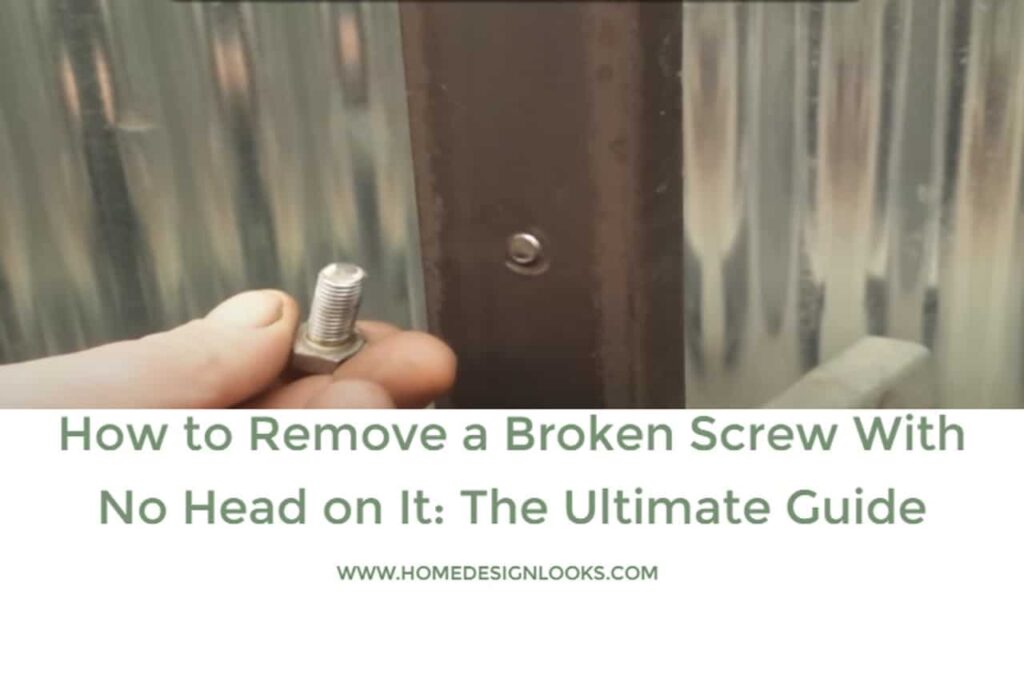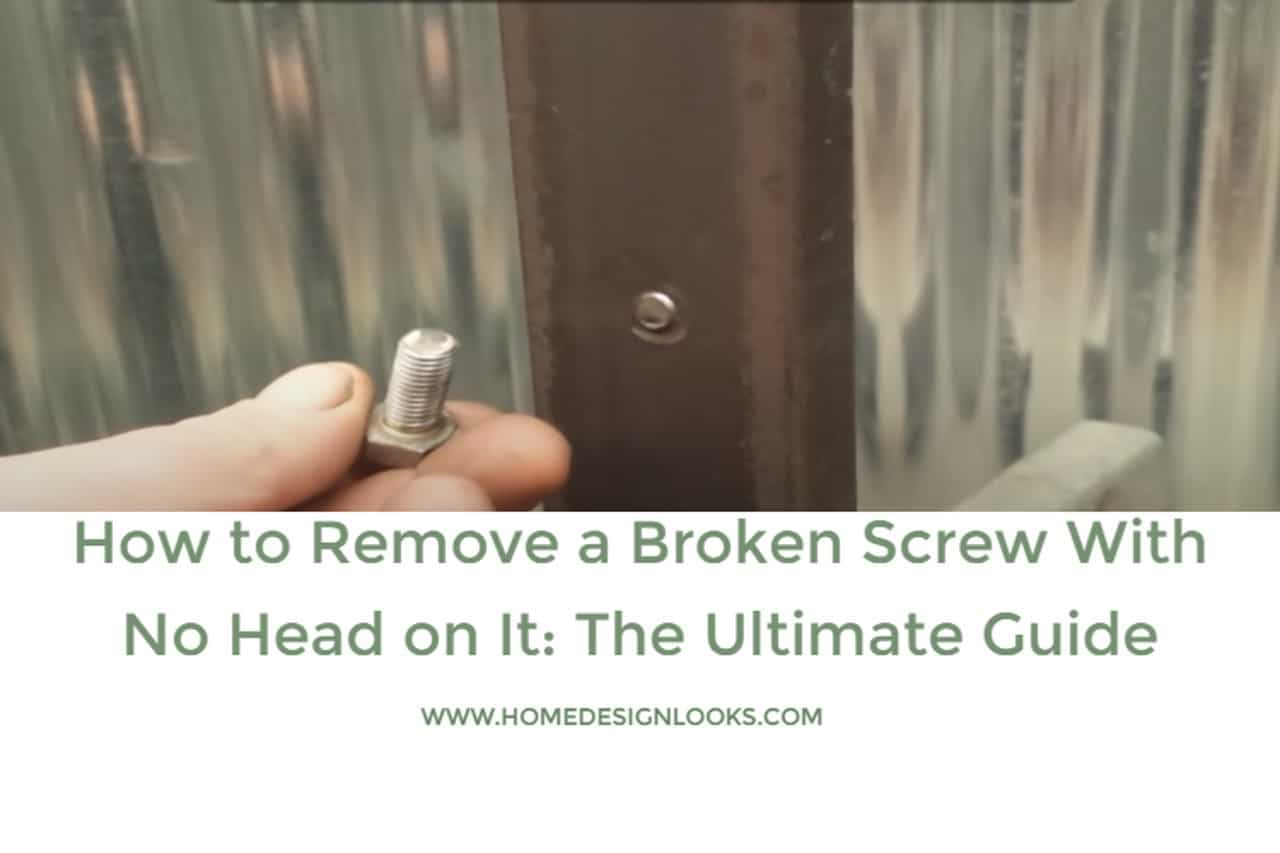
Removing a Screw with No Head from Metal: A Comprehensive Guide
Dealing with a screw that’s broken off flush with the surface, leaving you with no head to grip, can be incredibly frustrating, especially when working with metal. Whether you’re disassembling machinery, working on a DIY project, or repairing household items, a stripped or broken screw can halt your progress. This guide provides a comprehensive overview of various methods for removing a screw with no head from metal, ensuring you can tackle this common problem effectively and safely.
Understanding the Challenge
Before diving into the solutions, it’s crucial to understand why these screws break in the first place. Over-tightening is a primary culprit, as is using the wrong type of screwdriver. Corrosion can also weaken the screw, making it more prone to snapping. Understanding the cause can help you prevent future occurrences.
Essential Tools and Safety Precautions
Before attempting any removal method, gather the necessary tools and prioritize safety. Here’s a list of essential tools:
- Penetrating Oil: To loosen the screw.
- Screwdriver Set: Including various sizes and types.
- Screw Extractors: Designed specifically for removing damaged screws.
- Drill: With a set of drill bits, including left-handed drill bits.
- Pliers: Needle-nose and locking pliers for gripping.
- Hammer: For tapping and loosening.
- Center Punch: To create a starting point for drilling.
- Safety Glasses: To protect your eyes from flying debris.
- Gloves: To protect your hands.
Always wear safety glasses and gloves to protect yourself from potential injury. Work in a well-lit and ventilated area. If using power tools, ensure they are properly grounded and in good working condition.
Methods for Removing Screws with No Head
The Penetrating Oil Method
Often, the simplest solutions are the most effective. Start by applying penetrating oil to the broken screw. Let it soak for at least 15-30 minutes, or even overnight for stubborn screws. The oil helps to loosen any rust or corrosion that may be binding the screw in place. After the soaking period, try using pliers to grip any remaining portion of the screw and gently twist it out. This method is most effective when a small portion of the screw is still protruding.
Using a Screw Extractor
Screw extractors are specifically designed for removing a screw with no head from metal. They come in various sizes and types. Here’s how to use them:
- Center Punch: Use a center punch to create a pilot point in the center of the broken screw. This helps guide the drill bit.
- Drilling: Select a drill bit that is slightly smaller than the screw extractor. Drill a pilot hole into the center of the screw. Be careful not to drill too deep or damage the surrounding metal.
- Insert Extractor: Insert the screw extractor into the pilot hole.
- Turning: Using a tap handle or wrench, turn the screw extractor counterclockwise. The extractor’s threads will grip the screw, and as you turn, it will gradually back the broken screw out of the hole.
If the screw extractor breaks, it can be extremely difficult to remove, so apply steady, even pressure.
The Left-Handed Drill Bit Method
Left-handed drill bits can be highly effective for removing a screw with no head from metal. As you drill into the screw, the bit’s counterclockwise rotation can sometimes catch the screw and back it out without needing an extractor.
- Center Punch: Use a center punch to create a pilot point.
- Drilling: Select a left-handed drill bit that is slightly smaller than the screw. Drill into the center of the screw with moderate pressure.
- Extraction: If the drill bit catches, the screw should begin to back out. If not, proceed to another method.
Creating a New Head
If a portion of the screw is still protruding, you can attempt to create a new head using a few different methods:
Using a Dremel or Rotary Tool
A Dremel or rotary tool with a cutting wheel can be used to cut a slot into the top of the screw, creating a makeshift flathead screw. Once the slot is created, use a flathead screwdriver to attempt to remove the screw. Be careful not to damage the surrounding metal.
Welding a Nut to the Screw
If you have access to a welder, you can weld a nut to the top of the broken screw. The heat from the welding process can also help loosen the screw. Once the nut is welded in place, use a wrench to turn the nut and remove the screw. This method requires welding experience and appropriate safety gear.
Using Pliers or Locking Pliers
If a small portion of the screw is protruding, pliers or locking pliers can be used to grip the screw and turn it out. This method requires a firm grip and patience to avoid further damaging the screw or the surrounding material. Needle-nose pliers can be helpful for reaching screws in tight spaces. [See also: Best Pliers for Metalworking]
When to Call a Professional
If you’ve tried multiple methods and are still unable to removing a screw with no head from metal, it may be time to call a professional. A machinist or experienced mechanic will have specialized tools and techniques to remove the screw without causing further damage. This is especially important if the screw is in a critical component or if you’re concerned about damaging the surrounding material.
Preventing Future Problems
Prevention is always better than cure. Here are some tips to prevent screws from breaking in the future:
- Use the Right Screwdriver: Ensure you’re using the correct size and type of screwdriver for the screw. Using the wrong screwdriver can strip the head and make it more likely to break.
- Avoid Over-Tightening: Over-tightening is a common cause of broken screws. Tighten screws until they are snug, but avoid excessive force.
- Apply Lubricant: When working with screws in metal, apply a lubricant to reduce friction and prevent seizing.
- Use Quality Screws: Invest in high-quality screws made from durable materials. Cheaper screws are more likely to break.
- Consider Anti-Seize Compounds: For screws that are exposed to harsh environments, consider using an anti-seize compound to prevent corrosion and make future removal easier.
Conclusion
Removing a screw with no head from metal can be a challenging task, but with the right tools, techniques, and patience, it is often achievable. By understanding the various methods available and prioritizing safety, you can tackle this common problem effectively. Remember to assess the situation carefully, choose the appropriate method, and don’t hesitate to seek professional help if needed. By following these guidelines, you can minimize frustration and ensure successful screw removal, keeping your projects on track and your equipment in good working order. This guide offers several approaches to removing a screw with no head from metal, ensuring you’re equipped to handle this issue effectively. Remember to always prioritize safety and use the right tools for the job. Whether you’re a DIY enthusiast or a professional mechanic, mastering these techniques will save you time and frustration. Successfully removing a screw with no head from metal relies on careful planning and execution. By understanding the different methods and choosing the right approach, you can overcome this common challenge and keep your projects moving forward. The process of removing a screw with no head from metal can be simplified with the correct tools and techniques. Always remember to prioritize safety and take your time to avoid further damage. [See also: Metal Repair Techniques] Learning how to successfully removing a screw with no head from metal is a valuable skill for any handyman or mechanic. The ability to effectively removing a screw with no head from metal can save time and prevent further damage to equipment or projects. Understanding the best methods for removing a screw with no head from metal will help you tackle these challenges with confidence and efficiency. When removing a screw with no head from metal, always consider the surrounding material and use the gentlest method possible to avoid damage.

